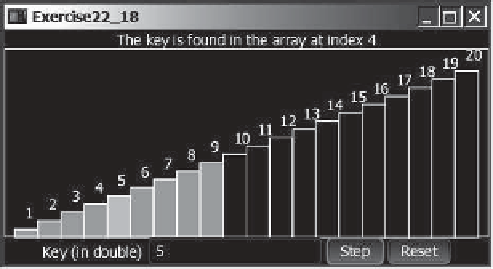Java Reference
In-Depth Information
F
IGURE
22.12
The program animates a linear search.
**22.17
(
Closest-pair animation
) Write a program that enables the user to add/remove
points by clicking the left/right mouse button, and displays a line that connects
the pair of nearest points, as shown in Figure 22.4.
**22.18
(
Binary search animation
) Write a program that animates the binary search algo-
rithm. Create an array with numbers from 1 to 20 in this order. The array ele-
ments are displayed in a histogram, as shown in Figure 22.13. You need to enter
a search key in the text field. Clicking the
Step
button causes the program to
perform one comparison in the algorithm. Use a light-gray color to paint the bars
for the numbers in the current search range and use a black color to paint the a bar
indicating the middle number in the search range. The
Step
button also freezes the
text field to prevent its value from being changed. When the algorithm is finished,
display the status in a label at the top of a border pane. Clicking the
Reset
button
enables a new search to start. This button also makes the text field editable.
F
IGURE
22.13
The program animates a binary search.
*22.19
(
Largest block
) The problem for finding a largest block is described in Pro-
gramming Exercise 8.35. Design a dynamic programming algorithm for solv-
ing this problem in
O
(
n
2
) time. Write a test program that displays a 10-by-10
square matrix, as shown in Figure 22.14a. Each element in the matrix is 0 or
1, randomly generated with a click of the
Refresh
button. Display each number
centered in a text field.
Use a text field for each entry. Allow the user to change
the entry value.
Click the
Find Largest Block
button to find a largest square
submatrix that consists of 1s. Highlight the numbers in the block, as shown in
Figure 22.14b. See
www.cs.armstrong.edu/liang/animation/FindLargestBlock.html
for an interactive test.



















Search WWH ::

Custom Search